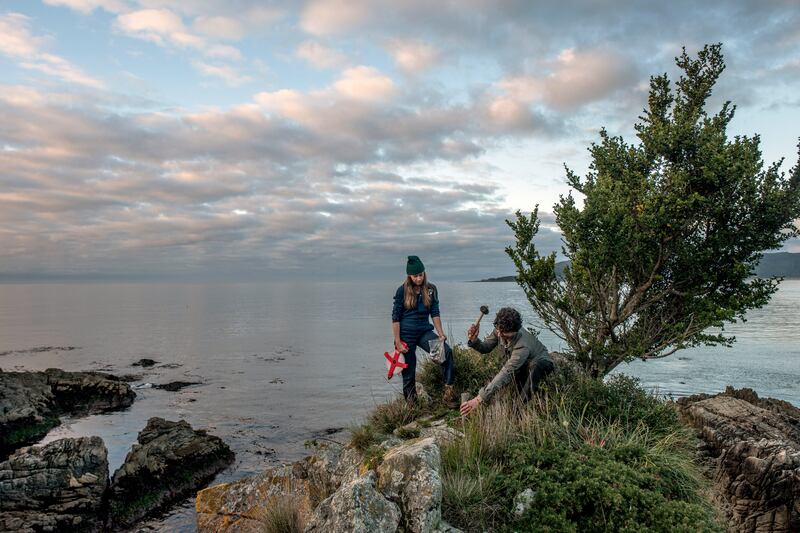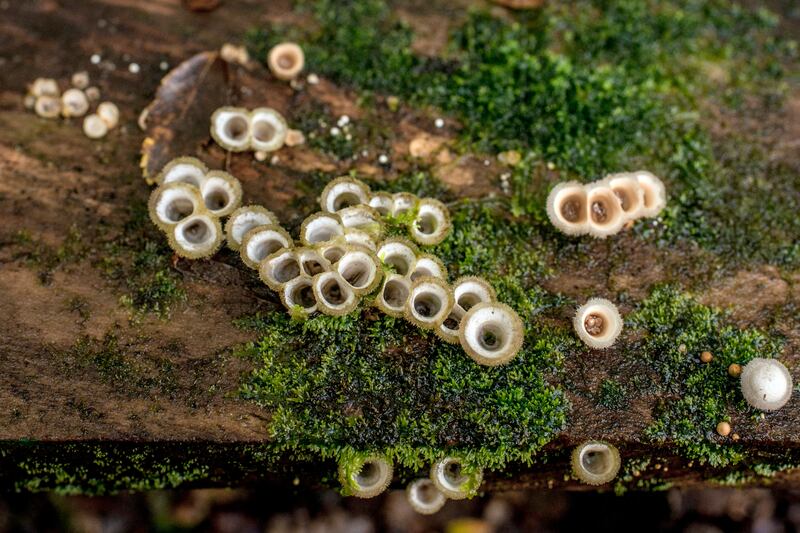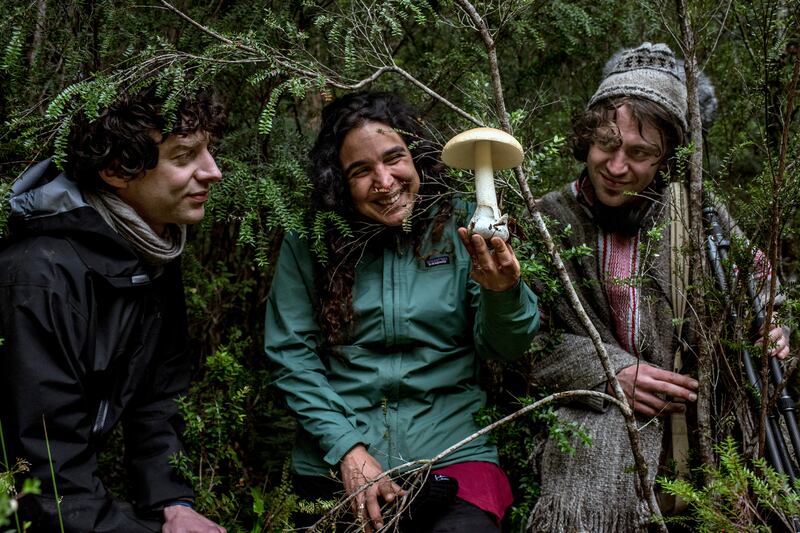Toby Kiers takes long strides across the spongy forest floor, feels the adrenline rush in her veins and stops at precisely the spot she has travelled so far to reach. Into the ground goes a hollow metal cylinder. Out comes a scoop of soil. Kiers sticks her nose into the dirt, inhales its scent, imagines what secrets it contains to help us live on a hotter planet. “What’s under here?” she asks. “What mysteries are we going to unveil?”
The soil is deposited into a clear plastic bag, then labelled with the co-ordinates of this exact location on Earth.
Kiers is a 45-year-old evolutionary biologist at the Free University of Amsterdam, and she is on a novel mission. She is probing a vast and poorly understood universe of underground fungi that can be vital, in her view, in the era of climate change.
Some species of fungi can store exceptional levels of carbon underground, keeping it out of the air and preventing it from heating up Earth’s atmosphere. Others help plants survive brutal droughts or fight off pests. There are those especially good at feeding nutrients to crops, reducing the need for chemical fertilisers. In short, they are what she calls “levers” to address the hazards of a warming climate. Yet they remain a mystery.
READ MORE

Kiers wants to know which fungi species are where, what they do, and which should be immediately protected. In short, she wants to create an atlas of all that which we cannot see. And all that is right under our feet.
“It’s seeing Earth’s metabolism,” she says. “Who is there? What is their function? Right now we are concerned so heavily on the overground, we are literally missing half the picture.”
Beneath our feet, fungal networks are an intriguing ally in efforts to tame global warming. The research is focused on mycorrhizal fungi, a type that has a symbiotic relationship with plant roots. Fungi give the trees much-needed nutrients extracted from the soil. In exchange, the trees supply carbon they’ve pulled from the air by photosynthesis. Fungi need carbon to grow. Carbon travels one way, and nutrients like nitrogen and phosphorous the other. This underground entanglement is vital to life above.
By one estimate, five billion tonnes of carbon flow from plants to mycorrhizal fungi annually. Without help from the fungi, that carbon would likely stay in the atmosphere as carbon dioxide, the powerful greenhouse gas that is heating the planet and fuelling dangerous weather. “Keeping this fungal network protected is paramount as we face climate change,” Kiers says. In addition, the biodiversity of underground fungi is a huge factor in soil health, which is crucial to the world’s ability to feed itself as the planet warms.
Specific knowledge of the power of these networks, says Tim Benton, a biologist at Leeds University, in England, who isn’t involved in Kiers’s work, is very patchy. “More information would be very valuable.”
Yet so little is known about fungi that they are not even counted in the Convention on Biological Diversity, the global treaty aimed at protecting nature. That treaty is aimed at plants and animals. Fungi are neither. They make up a separate kingdom of life altogether.
Underground, mycorrhizal fungi are crucial trading partners. Trees crave the nutrients they offer. Fungi gobble up the carbon that trees provide in return. To understand this kingdom, fungi aficionados argue, is to see the natural world differently – less as a collection of individual species, with humans dominating them all, and more as a web of organisms dealing with crises together.

The origin of life
Fungi made the world as we know it. As some of the first life forms on the planet, they consumed minerals locked in rocks, creating what we now know as soil. Without them there would be no plants on land and, therefore, no animals. No us.
Kiers’s expedition to southern Chile aims to fill in some of the gaps in knowledge about fungi, specifically the mycorrhizal fungi that live symbiotically with plant roots and drive carbon into the soil. That is what gives them such an urgent role on a hotter planet. “Mycorrhizal networks,” Kiers says, “are a major global carbon sink.”
The expedition was shaped by big data. With the help of scientists in Switzerland, an algorithm had crunched all kinds of above-ground information — temperature, soil moisture, types of trees — and deduced where in the world Kiers might find high and low levels of underground fungal biodiversity. Then it offered co-ordinates, as if to say, “Go here, take a soil sample, see if I’m right.”
For their first expedition, in Chile, the researchers arrived at each location, pinpointed by the algorithm, drew a grid 30m by 30m, collected spoonfuls of soil, bagged it and sent it to a local lab for genetic analysis. “Once we know who’s there, we can see what they’re good at,” Kiers says.
Her partner on this expedition was Giuliana Furci, a Chilean environmentalist who, as the head of the Fungi Foundation, an advocacy group, successfully lobbied to include fungi for protection under Chilean environmental law. Also on the expedition were the biologist and writer Merlin Sheldrake and his musician brother, Cosmo, who stuck microphones into the earth to record the sounds underground. Sometimes he captured the noise of gurgling liquids or the scratching, marching busywork of invisible organisms. Other times just the thud of the researchers’ boots nearby.

They scooped soil from under a volcano, crisscrossed pine and eucalyptus plantations, bushwhacked through brambles, climbed up rocks jutting into the Pacific, coaxed homeowners to let them onto their properties to take a bit of dirt. They rescued an injured parrot one day and a lost hiker on another.
Sometimes the algorithm led them to peaceful places, where Sheldrake says the “zen factor” was high. Other times not so much. One day they walked into a rainforest full of leeches.
Every day they smelled the soil they sampled, declared their verdicts.
Furci: “Peppery”.
Kiers: “Kind of pondish”.
Sheldrake: “Bit farty”.
Each sample, representing 1sq km of land, would be used to identify the genetic properties of fungal species that were storing particularly high levels of carbon in the dirt, or which species might help trees adapt to drought. Kiers says she aims to collect 10,000 samples over 18 months.
Mushroom whisperer
“Volva. Volva!” Furci yells in excitement. In her hand she holds a thing that looks like an egg cup from which a mushroom has emerged, pale and cloudy like milk — a volva. “A native amanita,” she says, smiling. “Look at the volva. Volva. With an O.”
Mushrooms are the above-ground avatars of the fungi kingdom, but they represent a fraction of the fungal web underground. Furci spots them everywhere. Concealed on the forest floor, wrapped around fallen twigs, attached like luminescent clams on branches. You have to be there in the brief window of time when they are visible. “All mushrooms are magic,” she says.


Furci was born and raised in England, where her mother, a political dissident, lived in exile during the dictatorship of Augusto Pinochet. She came to Chile when her mother returned home; a few years later she had what she calls “an encounter”. She saw a striking rust-orange mushroom in a forest — she later learned it was part of the genus Gymnopilus – and wanted to know more. An obsession began.
Since then Furci has written guidebooks on fungi and named unnamed species (a pitch-black mushroom with white scales she calls “galactica”). She has helped persuade the International Union for the Conservation of Nature to include fungi as a category to protect, alongside flora and fauna.
When asked what fungi do, or how they behave, Furci becomes visibly annoyed. Their vast biodiversity is not only underexplored, she says; they are also misunderstood. They are thought to be just one thing, but they are not. “A morel and a button mushroom are as closely related as a flea and an elephant,” she says.
In the course of a day she identifies nine mushrooms. One resembles a hamburger-bun top, another a witch’s hat. The colours range from vanilla to deep raspberry to the speckled back of a fawn. By the end of a brief trek she has scooped up two fistfuls of Lactarius delicious, which grow abundantly alongside the pine trees planted there to harvest timber, one of Chile’s main exports. Without this fungi, Furci points out, pines wouldn’t survive. For dinner that night the Lactarius are sauteed in butter.
An old tree’s oldest friends
Kiers grew up in small towns in Connecticut and Maine. Her parents sent her out with her sister to collect morels in summer. The underground became her passion. She studied biology at Bowdoin College, in Maine, worked at a research station in Panama and earned her doctorate at the University of California, Davis. She cofounded a nonprofit advocacy group, the Society for the Protection of Underground Networks.
One recent Thursday afternoon, Kiers walks through a dark, gnarly rainforest with a fellow underground fungus scholar, César Marín, from the Universidad Santo Tomás, in Chile. They are walking in an extraordinary place. A very old, very slow-growing rainforest, this section of the forest potentially holds some of the largest and oldest stores of carbon on Earth. It is home to one of the oldest trees on Earth, a massive Fitzroya, or alerce in Spanish, estimated to be at least 3,500 years old, known here as the great-grandfather alerce.
Kiers says the data they collect here will signal which mycorrhizal fungi species are doing the work of sequestering so much carbon underground.
Fungi are sensitive to human activity. Chemical fertilisers diminish their volume and diversity. Logging destroys them.
Climate change is the latest stressor, which is why Marín was keen for Kiers to sample the same three plots he had tested seven years ago. He wants to know if the megadrought that has been melting Chile’s glaciers over the past few years has also changed the mycorrhizal networks underground.
Fungi have helped trees adapt on a millennial scale. They could be crucial to helping trees adapt in the climate crisis. “In difficult times, organisms find new symbiotic relationships in order to expand their reach,” says Merlin Sheldrake, the biologist. “Crisis is the crucible of new relationships.”
They walk briskly. Fern fans out in the understorey, along with canelo trees, bamboo and tall, slender alerce, for which this park is named.
Kiers approaches the great-grandfather tree in silence. She takes off her hiking boots, walks gently around the fragile roots.
Cosmo Sheldrake takes out a tin whistle and plays.
The tree stands 30m tall. Its craggy trunk is half-dead. Hundreds of fungal species are associated with its root system, Marín says.
Being near it, Kiers says, feels dizzying.
“Wouldn’t you want to know about this healthy partnership that’s lasted 5,000 years through so many changes?” she says. It is clearly a rhetorical question.

On the last Friday evening of their weeklong expedition, they hike to a rocky outcropping on the coast. “Zen factor is high,” Merlin Sheldrake says.
An otter plays in the water. The sun shines golden on the lapping waves. Some of the boulders are dotted with lichen the colour of marigold. As they have for millennia, Sheldrake observes, fungi are eating rock.
By the end of this one-week outing they have collected 30 bags of soil. Nearby, over the next several weeks, Marín’s team will gather 64 more. It’s a drop in the bucket, considering the thousands needed to construct the global map they envision.
This week Kiers is on the other side of the world, in the Apennines, the mountain range in Italy. North of the place she planned to collect samples, a glacier has collapsed. Wildfires rage nearby. “This is a race against time,” she says in an email. “We are nervous these fungal communities are disappearing before we can even document who is there.” — This article originally appeared in The New York Times

















